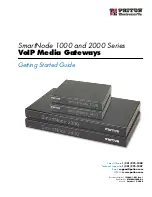
Version 6.6
687
Mediant 3000
User's Manual
53. Configuration Parameters Reference
Parameter
Description
servers are unavailable.
When the device falls back to the Outbound IP Routing Table, it
continues scanning for a Proxy. When the device locates an active
Proxy, it switches from internal routing back to Proxy routing.
Note:
To enable the redundant Proxies mechanism, set the parameter
EnableProxyKeepAlive to 1 or 2.
Web/EMS: Prefer Routing
Table
[PreferRouteTable]
Determines whether the device's internal routing table takes
precedence over a Proxy for routing calls.
[0]
No = (Default) Only a Proxy server is used to route calls.
[1]
Yes = The device checks the routing rules in the Outbound IP
Routing Table for a match with the Tel-to-IP call. Only if a match is
not found is a Proxy used.
Web/EMS: Always Use
Proxy
[AlwaysSendToProxy]
Determines whether the device sends SIP messages and responses
through a Proxy server.
[0]
Disable = (Default) Use standard SIP routing rules.
[1]
Enable = All SIP messages and responses are sent to the Proxy
server.
Note:
This parameter is applicable only if a Proxy server is used (i.e.,
the parameter IsProxyUsed is set to 1).
Web: SIP ReRouting
Mode
EMS: SIP Re-Routing
Mode
[SIPReroutingMode]
Determines the routing mode after a call redirection (i.e., a 3xx SIP
response is received) or transfer (i.e., a SIP REFER request is
received).
[0]
Standard = (Default) INVITE messages that are generated as a
result of Transfer or Redirect are sent directly to the URI, according
to the Refer-To header in the REFER message, or Contact header in
the 3xx response.
[1]
Proxy = Sends a new INVITE to the Proxy.
Note: This option is applicable only if a Proxy server is used and the
parameter AlwaysSendtoProxy is set to 0.
[2]
Routing Table = Uses the Routing table to locate the destination
and then sends a new INVITE to this destination.
Notes:
This parameter is applicable only to the Gateway / IP-to-IP
application.
When this parameter is set to
[1]
and the INVITE sent to the Proxy
fails, the device re-routes the call according to the Standard mode
[0].
When this parameter is set to
[2]
and the INVITE fails, the device re-
routes the call according to the Standard mode
[0].
If DNS resolution
fails, the device attempts to route the call to the Proxy. If routing to
the Proxy also fails, the Redirect/Transfer request is rejected.
When this parameter is set to
[2],
the XferPrefix parameter can be
used to define different routing rules for redirect calls.
This parameter is disregarded if the parameter AlwaysSendToProxy
is set to 1.
Web/EMS: DNS Query
Type
[DNSQueryType]
Enables the use of DNS Naming Authority Pointer (NAPTR) and
Service Record (SRV) queries to resolve Proxy and Registrar servers
and to resolve all domain names that appear in the SIP Contact and
Record-Route headers.
[0]
A-Record (default)
Summary of Contents for Mediant 3000
Page 2: ......
Page 26: ...User s Manual 26 Document LTRT 89729 Mediant 3000 Reader s Note...
Page 27: ...Part I Getting Started with Initial Connectivity...
Page 28: ......
Page 40: ...User s Manual 40 Document LTRT 89729 Mediant 3000 Reader s Notes...
Page 41: ...Part II Management Tools...
Page 42: ......
Page 44: ...User s Manual 44 Document LTRT 89729 Mediant 3000 Reader s Notes...
Page 80: ...User s Manual 80 Document LTRT 89729 Mediant 3000 Reader s Notes...
Page 98: ...User s Manual 98 Document LTRT 89729 Mediant 3000 Reader s Notes...
Page 103: ...Part III General System Settings...
Page 104: ......
Page 113: ...Part IV General VoIP Configuration...
Page 114: ......
Page 144: ...User s Manual 144 Document LTRT 89729 Mediant 3000 Reader s Notes...
Page 164: ...User s Manual 164 Document LTRT 89729 Mediant 3000 Reader s Notes...
Page 222: ...User s Manual 222 Document LTRT 89729 Mediant 3000 Reader s Notes...
Page 224: ...User s Manual 224 Document LTRT 89729 Mediant 3000 Reader s Notes...
Page 275: ...Part V Gateway and IP to IP Application...
Page 276: ......
Page 278: ...User s Manual 278 Document LTRT 89729 Mediant 3000 Reader s Notes...
Page 399: ...Part VI Session Border Controller Application...
Page 400: ......
Page 402: ...User s Manual 402 Document LTRT 89729 Mediant 3000 Reader s Notes...
Page 464: ...User s Manual 464 Document LTRT 89729 Mediant 3000 Reader s Notes...
Page 465: ...Part VII Stand Alone Survivability Application...
Page 466: ......
Page 474: ...User s Manual 474 Document LTRT 89729 Mediant 3000 Reader s Notes...
Page 494: ...User s Manual 494 Document LTRT 89729 Mediant 3000 Reader s Notes...
Page 497: ...Part VIII IP Media Capabilities...
Page 498: ......
Page 501: ...Part IX High Availability System...
Page 502: ......
Page 515: ...Part X Maintenance...
Page 516: ......
Page 522: ...User s Manual 522 Document LTRT 89729 Mediant 3000 Reader s Notes...
Page 524: ...User s Manual 524 Document LTRT 89729 Mediant 3000 Reader s Notes...
Page 552: ...User s Manual 552 Document LTRT 89729 Mediant 3000 Reader s Notes...
Page 562: ...User s Manual 562 Document LTRT 89729 Mediant 3000 Reader s Notes...
Page 565: ...Part XI Status Performance Monitoring and Reporting...
Page 566: ......
Page 578: ...User s Manual 578 Document LTRT 89729 Mediant 3000 Reader s Notes...
Page 609: ...Part XII Diagnostics...
Page 610: ......
Page 624: ...User s Manual 624 Document LTRT 89729 Mediant 3000 Reader s Notes...
Page 626: ...User s Manual 626 Document LTRT 89729 Mediant 3000 Reader s Notes...
Page 638: ...User s Manual 638 Document LTRT 89729 Mediant 3000 Reader s Notes...
Page 639: ...Part XIII Appendix...
Page 640: ......
Page 864: ...User s Manual 864 Document LTRT 89729 Mediant 3000 Reader s Notes...
Page 871: ...Version 6 6 871 Mediant 3000 User s Manual 55 Selected Technical Specifications Reader s Notes...
















































